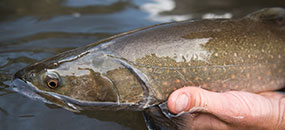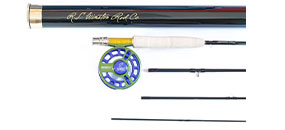04/15/2008
Contacts:
Clint Sestrich: (406) 823-6985, Travis Morris: (406) 599-3356
FOR IMMEDIATE RELEASE:
Orvis and Trout Unlimited to Work on Restoration Project in the Gallatin National Forest
The Madison Gallatin Chapter of Trout Unlimited (TU), Orvis and volunteers from the area will team up to assist the Gallatin National Forest fisheries biologists in collecting and preparing tree cuttings for a restoration project along the South Fork of the Madison River and the Duck Creek gravel pit. Volunteers are needed from 10 a.m. to 3 p.m. on Friday, April 25.
Volunteers will take cuttings from dormant willow and cottonwood trees along Grayling Creek, Duck Creek, and Cougar Creek in the Hebgen Basin. The willows and cottonwoods will then be planted in June along the South Fork of the Madison River and around the Duck Creek gravel pit pond on newly acquired Forest Service land. The vegetation will stabilize eroding banks, buffer the river from sediment and enhance habitat for fish and wildlife.
"The project is important to the area to help rehabilitate and enhance habitat for a wide variety of aquatic and terrestrial species" said Clint Sestrich, Fishery Biologist at the Hebgen Lake Ranger District.
Organized by the Madison Gallatin Chapter of Trout Unlimited, the project is the culminating event of a two-day meeting of Orvis's regional outfitters and guides program in Bozeman.
Volunteers should dress for the weather and bring snowshoes and/or waders as well as gloves, eye protection, and pruners, if they have them. Volunteers will meet at the junction of Highways 191 and 287 (the Duck Creek Y) north of West Yellowstone. The Madison Gallatin TU Chapter will provide lunch. Volunteers should contact Travis Morris, TU Madison Gallatin Chapter Vice President, at (406) 599-3356 or bonefish@bresnan.net.
Trout Unlimited is North America's leading coldwater fisheries conservation organization, with more than 150,000 members.
-30-
More Information
Project Background:
Several projects in the Hebgen Basin require rehabilitation via the establishment of woody riparian vegetation. These include:
1. Duck Creek Gravel Pit Pond
The Duck Creek gravel pit pond is located on a parcel of land recently acquired by the Forest Service. Although the pond has tremendous potential for providing habitat to a suite of aquatic and terrestrial species, lack of riparian vegetation is likely limiting its use. To rehabilitate the gravel pit and enhance habitat for aquatic and terrestrial animal species, willows and cottonwoods will be planted by hand around the shoreline.
2. South Fork Madison River Streambank Stabilization
In 2006, Gallatin National Forest Fisheries Staff removed a fishing platform located near a recreation residence cabin along the South Fork Madison River. Over time, the fishing platform had fallen into disrepair and was contributing to downstream bank erosion. Although the structure has been removed and the bank treated with erosion control material, riparian vegetation is needed to further stabilize eroding banks.
3. South Fork Madison River Road Buffer
The South Fork Road, located South of West Yellowstone, parallels the South Fork Madison River for approximately 3.7 miles. This includes several road segments that pass very close to the river and as a result, likely convey substantial amounts of sediment to the stream channel. However, sediment delivery could be minimized by planting a buffer of willow vegetation between the road and stream at several locations.
Methods:
In late April, volunteers will use pruning sheers to harvest cuttings from dormant willows and cottonwoods along Grayling Creek, Duck Creek, and Cougar Creek in the Hebgen Basin. Next, volunteers will trim the apical buds from the top of cuttings so that energy will be redirected toward root buds. The tops of the cuttings will then be painted with a 50:50 mix of latex paint and water to minimize water transpiration and disease while allowing planters to know which end to plant in the ground. Cuttings will be stored in a cool, dark building at the Hebgen Lake Ranger District to ensure that they remain dormant until planted.
Once snow has melted and high water has subsided, cuttings will be soaked in water for one week prior to planting to promote root growth. GNF staff and volunteers will then plant cuttings in early June.
Date: 4/22/2008



